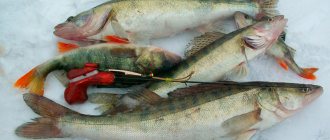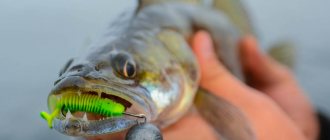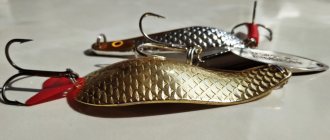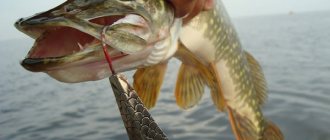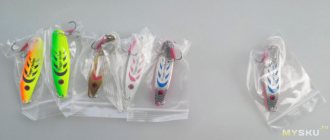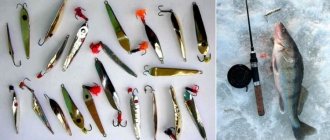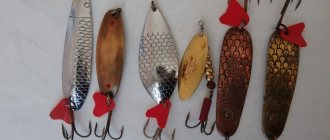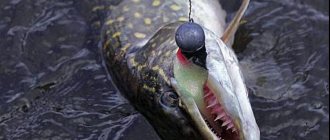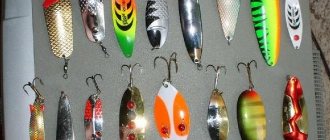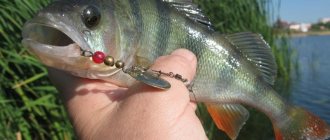Review of the best lures for pike perch - according to anglers' reviews To successfully catch pike perch, baits with a certain set of properties are required. The choice of the best lure for pike perch is based on the angler’s knowledge of the food supply that the fanged predator obtains in the reservoir.
Since the structure of the pike perch’s mouth does not allow it to swallow large live bait with a wide body, it is important to take this feature into account first when choosing bait. The pike perch spoon should be narrow and oblong, of short length. The bait can resemble the behavior in water of bleak, roach, gudgeon, goby, vendace, ruff, etc.
The action of the bait should be active; pike perch is especially aggressive towards the vertical component of the retrieve. Therefore, having chosen a lure, it is necessary to carry it out correctly.
One of the best lures for pike perch is the classic step. Moreover, the spinner should not float in the water for a long time. This raises another important requirement for the bait: it must have a suitable weight that will allow it to reach the spoon surface of the bottom with the required speed.
Despite the fact that the fanged predator reacts more to the vibrations emanating from the play of the spinner, the color of the bait also matters: silver models have an advantage. For each specific body of water you will have to select your own catchable spoon. Our rating of the best lures for pike perch, based on reviews from experienced amateur fishermen and athletes, will help you in this difficult choice.
When catching pike perch with spoons, it is important to consider the time of year . Each season has its own characteristics associated with the behavior of the predator.
From late autumn to early spring , when the water temperature is low, pike perch does not chase prey, but lies in wait for it in shelters. At this time, vertical spinners work best, as they are able to find a fanged robber and provoke him with their play.
From mid-spring to early autumn, you can use baits with horizontal movement. Rotating spoons and spoons work well during this period. The wiring can be either uniform or jerky.
Autumn is the best time to fish for fanged fish using the jig method. However, along with soft baits, oscillating spoons, castmasters and jigs work great. In addition, at the beginning of autumn you can excellently fish at night, and for this the bait must have a noise accompaniment or flicker dimly under water.
Only with a consistent and deliberate approach to choosing a spoon can you hope to catch a worthy pike perch. Try it, look for your spinner. Good luck with your fishing!
Total votes – 10, rating – 4. 2 Please note that the reliability of information and rating results is subjective and does not constitute advertising
Advertising on the website Fishing for pike perch in winter is a fascinating and interesting activity. But there are some features that should be taken into account, for example, which spoons are best to use for winter fishing for pike perch. Many anglers who have been successfully catching pike perch in the winter for many years note the fact that spinners from . Let's look at their main features and the nuances of their use when fishing for pike perch in winter.
What do you need to know about winter lures for pike perch?
Winter versions of lures for pike perch differ from summer options in that when fishing with winter lures, the highest parameters of efficiency in catching pike perch can be achieved by playing such lures in vertical directions. For summer options, the opposite is true.
Lures for winter fishing for pike perch can be of two types. Williams baits of large or medium size are better suited for fishing in winter.
The difference between such spinners from this company is the presence of narrow shapes of the spinners themselves, which is very important when catching pike perch. In addition, the company’s specialists did their best and took into account the main features of fishing for pike perch in winter and made the parameters of their spinners most suitable for the winter characteristics of catching pike perch, regardless of winter weather conditions.
Thanks to their excellent qualities and ability to glide in the water column, pike perch are excellently caught using Williams spinners. They are distinguished by very high characteristics of their strength, flexibility and durability of their application.
Williams spinners for ice fishing
Winter Williams spinners differ from summer ones, since in winter they use vertical, and in summer - horizontal movement of the spinner. When fishing in winter, medium and large-sized baits are used:
When hunting for pike perch in winter, anglers prefer Williams spinners. The design of these baits takes into account the narrow mouth of the pike perch, the color matches the fish that the predator is hunting, and when the fishing rod is immersed and raised, the spoon oscillates beautifully. All this attracts predators, contributes to a good bite and a large catch.
Common types of winter lures for pike perch fishing
Winter lures are typically played in a vertical position. In this case, either one or several hooks can be located on one narrow plate; on the other side there is a special hole for securing the fishing line. The arsenal also includes spinners for winter fishing for pike perch in the shape of a curved arc, somewhat reminiscent of a rocker. The fishing line is secured to such a spinner at the center of gravity of the spinner itself. In this case, the hooks are fixed at both ends of the spoon. The winter spinner “Dragon”, of large mass, is also common; when fishing with such a spinner, if the fish breaks off the hook, it is severely damaged. Some anglers like to catch pike perch in the winter using a spinner called a “Train”, this design has several spinners following each other. The Luch spinner is slightly elongated in length and bend.
The Vlasov spinner is one to one and a half centimeters thick. It is made in the form of a structure with a bend, which is located in the longitudinal direction; among other things, this spoon has a vertical crossbar. There is a spoon called “Nurse”, which in most cases is used for catching pike perch in lake reservoirs, has two bends, which are located in both the longitudinal and transverse directions.
The “Boat” spoon is shaped like an oval; when fishing with it, it is necessary to constantly change the trajectory of its movement using the active fishing method.
[custom_ads_shortcode2]
Catchable Williams spinners - what are the differences?
- Many fishermen who have mastered winter lures from zander fishing speak very flatteringly about them. In their opinion, these spoons are superior in many of their characteristics to all other winter baits for pike perch.
- For example, the “Wabler” spinner, with various parameters of the pike perch fishing technique, shows very good catch results. Moreover, it is excellent for catching pike perch both at great depths and in shallower areas of reservoirs.
- Very good performance is shown by the spinners of this company, which, based on their design, produce oscillatory movements of small parameters, reminiscent of the trajectory of a fish’s fall.
- Anglers speak well of such spinners as “Fjord Spoon” or “Little Cleo”. It is these spoons that help to achieve a good catch at great depths and in the river flow.
- Williams spinners from the “Colorado” series, which are very similar in their external shape to a spoon, have good performance.
[custom_ads_shortcode3]
Williams spinner for certain types of fish
For zander
Pike perch, along with pike and perch, is one of the most popular breeds of predatory fish. The Williams range includes the following models that are ideal for catching this prey:
- Ice Jig J60GN weighing 14g is considered one of the best baits for pike perch and pike from this manufacturer. If there is no prey in the reservoir, there is also a possibility of a bite from brown salmon, brown trout or pink salmon.
- The Quick Silver RB 30 has the dimensions and weight that make the bait suitable for catching medium to large pike perch. The model is equipped with powerful open-type tees that penetrate even the hardest pike-perch jaw, which minimizes the loss of prey.
- Wabler Lite W55S is one of the most attractive lures for zander or pike. Most anglers note that the silver spoon is the most catchy.
For trout
Trout is another fairly common catch, the catching of which is accompanied by a number of difficulties, since this fish is characterized by innate caution and timidity.
For this reason, the correct choice of bait is of particular importance; among the Williams assortment, the following baits are best suited for these purposes:
- HQ-QV NL 110 is the most ideal option for trout fishing; with its help you can catch trophy specimens.
- Wabler W30G is a universal bait; its main advantage is that in the absence of a bite from trout, it becomes possible to fish for other prey.
- Sparky is suitable for catching any predators, but trout and pike perch are the ones that bite best on it.
How to catch pike perch using a Williams spinner in winter?
We took into account the ability of pike perch to recognize baits and lures that are dangerous to fish, and therefore, to successfully use spinners from this company, anglers can use the most varied and sophisticated ways of playing the game. The employees took into account all the features of winter fishing for pike perch, so their baits for this fish are very similar to the main characteristics and behavior of the fish that the pike perch itself feeds on.
It should be noted that in winter, pike perch are less active compared to summer, spring or autumn. Therefore, in order for the fisherman to be able to attract the attention of this fish, it is necessary to make a lot of effort. When approaching the spoon, pike perch begin to study and carefully monitor the bait; if something seems suspicious to them, they will not launch an attack. Williams spinners are very similar to real fish and completely imitate their behavior, and therefore are very attractive to pike perch.
[custom_ads_shortcode1]
Varieties of spinners
There are many varieties of Williams spinners. The choice of bait depends on the individual characteristics of the reservoir, as well as the fish being fished for.
It is worth noting that the Williams spinner has the best effect on pike perch. This is due to the fact that most Williams lures have a shape and color that appeals most to pike perch. When fishing for pike perch at shallow depths, a smooth horizontal retrieve is best. Pauses lasting no more than 2 seconds will only cause additional interest in the predator. For fishing at a depth of more than 5 meters, it is recommended to use vertical wiring (as with jig fishing).
There is also a large assortment of Williams spinners for winter fishing. They are different from those used for fishing in the summer. This is due to the fact that in winter fishing horizontal fishing is used, and in summer fishing - vertical. The most popular Williams spinners used for winter fishing are:
- Rocker-shaped. The peculiarity of this bait is that its center of gravity is located in the hole for the fishing line. The location of the hooks in the nozzle is double-sided (top and bottom).
- Vertical. The vertical Williams spinner is a metal plate. On one side there is a hole for threading fishing line, and on the other there is one or more hooks.
- "The Dragon". The nozzle is quite massive and large. It is not particularly popular among fishermen. If the fish falls off, it can be seriously injured.
Williams spinners can also be distinguished by color. The most common of them are:
- GN (gold)
- SN (silver),
- COP (brown)
- HN (half gold, half silver),
- EB (half blue, half white).
The fish are most interested in the blue and white bait. The fact is that when retrieving, the white half of the nozzle throws off glare that attracts fish. The purpose of the second half is to make the lure as similar as possible to a live fish.
Fishing technique
Some fishermen, in order to attract passive pike perch in winter, begin to use the spinner technique, which uses low-amplitude vibrations of the spinner.
A fairly common technique for catching pike perch in the winter is to toss a spoon using a short movement of the angler’s hand. At the same time, a kind of wave comes from the fisherman’s hand, which is transmitted to the fishing rod and fishing line, and ultimately to the lure itself.
Many anglers prefer to play with a spinner, when the spinner itself seems to glide through the water column. Such movements are somewhat reminiscent of the behavior of wounded fish. That’s why pike perch are very interested in such baits.
William spinners for winter fishing for pike perch have very good fishing qualities, allowing the fisherman to carry out all sorts of movements and carry out different techniques. These parameters have made these spoons very common among anglers.
[custom_ads_shortcode2]
Share link:
Recommendations from partners.
The famous Canadian manufacturer of spinners, the Williams company, has a hundred-year history, and during this time it has gained great trust from consumers around the world. The company was founded back in 1916, and almost from the very beginning it produced very high-quality products made from expensive materials. The coating of some spinners is made of silver and gold, so counterfeiting of such products is practically impossible.
Brief history The Williams brothers, the founders of the company, were developing gold deposits and saw the heyday of the gold rush. They had a practical approach to business, and they sought to use the mined gold as a material. So, in 1897, the brothers created their first company, which produced gold teeth. Both of them were active fishermen, and over time they focused their attention on the production of spinners. Experiments with coating spinners with silver and gold gave excellent results, and the famous company was founded in 1916. In the same year, their signature product, the Wabler spinner, was released.
Features of production The main material for Williams spinners is high-grade brass. This material was not chosen by chance, and it has a number of advantages compared not only to iron, but also to stainless steel. Brass does not rust, sounds great in water, it is strong and flexible, quite easy to process, and at the same time can be combined with other metals, at least with the same precious ones.
Production takes place using this technology - a roll of brass passes through an automatic press matrix, which can make thousands of blanks at once. The plant's capacity allows for the production of 6,000 spinners per hour. A characteristic feature of all these baits is a longitudinal groove, which makes them more stable in the water. In some ways, such a gutter is similar in functionality to a ship’s keel.
The complete manufacturing process of spinners goes through as many as 24 stages, starting from the moment of cutting out the brass blank. Initially, they are mounted in frames that allow hundreds of spinners to be dipped into the cleaning solution at once in order to completely remove any possible dirt or deposits from them. Next, there is a sequential immersion in vats of various acids, where an important galvanic process takes place.
Brass is coated externally with a thin layer of copper and then coated again with nickel. Even at this stage, Williams spinners have much better characteristics than cheap Chinese consumer goods. But work with them is just beginning - the already nickel-plated surface is perfectly cleaned, and then a gold or silver coating (20 carats of precious metal) is applied to it.
This greatly enhances the fishing qualities of the bait. For example, Williams spinners are known all over the world for their unique light play. Even at a depth of 4-5 meters, the fish will see such a spoon and bite on it.
And the precious metal does not fade over time. Those spoons that were produced a hundred years ago still look bright, like a real jewel. For this reason, Williams products are very expensive, but those who can afford such a purchase will never be disappointed in it.
Popular models of Williams brand spinners perform well in any fishing conditions - both summer and winter, in different bodies of water. These are truly universal baits, and they are guaranteed to attract the attention of a wide variety of predatory fish. Here is just a short list of fish species that simply cannot swim past such bait - trout, salmon, pike, pike perch, bass, perch, brown trout, etc. These spoons guarantee a catch in any conditions, as long as they are delivered within the fish’s field of view.
The legendary Williams Wabler has already celebrated its centenary. Today it is produced in almost the same form as in 1916. This is one of the most sought-after baits in the entire company's range, with unique performance characteristics, whose advantages have been confirmed by many thousands of wealthy fishermen around the world over generations of use.
Its versatility is especially good for all-season use - it is equally suitable for fishing in any weather and at any time. The range of working depths of the Wobbler spinner is from shallow water to 6 meters.
Micro-oscillators are also very popular in the company’s product range. They are available in different sizes - from 25 to 38 mm. They will work well for small fish, such as perch or bleak, but for larger trout or ide you will need sizes up to 67 mm.
In the Williams product range there are even larger spinners, 102 mm. They have already caught very large, trophy fish - catfish, large pike, salmon.
Experienced fishermen recommend alternating types of retrieves (this is universal advice that is suitable for any fish and any bait), using either the classic stepped or stop-n-go, with frequent descents to the very bottom. In this case, Wobbler spinners behave very well with free gliding; fish very often bite on them at this time.
Another very successful model is the Williams Ice Jig - this is really a jig for fishing under ice. It is used in different ways, both for casting and for vertical plumb. This bait has a very well defined characteristic groove, which gives it not only stable play, but also gliding with a slight wobble, which the fish really like.
Williams Ice Jig has three hooks at once - two additional ones in the very center, which is quite unusual for spinners. Additional hooks give good results. The bait is quite narrow, so it can quickly sink to the very bottom of the reservoir.
Its shape and weight are carefully balanced, so the inertia of the water flow cannot bring the spoon to the surface. Even in bodies of water with strong currents, it will behave as it should. If there is no particular current, then jig wiring will work well for this bait.
Autumn, the Williams Dartee model is original in form and characteristics. It has a very high concavity, an unusual bend. The company began producing this bait in 1990.
The unusual shape allows the spoon to make a kind of “yaw” movement, which attracts fish even from afar. Also, this spoon has a very well balanced weight, which allows it to quickly and confidently go deeper in the water. Slow retrieves and medium-depth ponds are recommended for this bait.
This model also well reveals the potential of spinners, which is obtained at the time of galvanization, even at the manufacturing stage. The moment they touch the water, these baits create a so-called galvanic couple and emit electromagnetic waves. This has an extremely positive effect on the fish’s sensory organs, so predators immediately begin to look for the source of the “signal”.
Of course, plastic or silicone baits cannot boast of anything like this. If you constantly pause while retrieving, the spoon of this model will show an excellent catch. It is very effective in both winter and summer, and is clearly visible to fish even at night.
Williams Quick Silve is one of the smallest in weight in the company's range. At the same time, it is perfectly balanced, has a well-thought-out geometry, and is best suited for slow retrieves with long pauses. This model is best used in the hot season, for well-fed and passive fish.
For example, it is great for catching pike, even if the predator is completely lazy and doesn’t bite anything else. This bait model is also interesting because it can be hooked in different ways - both from the front and from the back, simply by changing the position of the hook. This allows, under other identical conditions, to always get two different games in the water column.
And in the Williams Quick Silve model, a hologram is applied to the precious coating, which further interests the fish. This bait is available in a large number of colors.
Williams spinners are a world-famous brand, a symbol of quality, deservedly considered the best of their kind. Not every fisherman will be able to afford a spoon coated with gold, or at least silver, but the regular large catch from its presence will more than justify the initial monetary cost of the bait.
Williams spinners are versatile and very catchy fishing tackle produced by the company of the same name from Canada. They are designed for catching various types of predatory fish, and their effectiveness increases during a certain fishing season (summer or winter).
[custom_ads_shortcode3]
Catchable colors of Williams Wobbler lures
The main catchable colors of Williams Wabler spinners are S (silver), G (gold) and H (half silver, half gold). These colors copy the coloring of the main food fish - roach and bleak, and for standing reservoirs - crucian carp.
On large reservoirs, the most killer color is EB (electric blue - white and blue). Moreover, not only pike, but also pike perch, bite well on this coloring if it happens to be in this fishing horizon, which often happens on warm summer evenings.
Main working colors of Williams Wobbler spinners.
In muddy water, the Williams spinner for pike in flashy, provocative colors comes to the aid of the angler. The color “yellow background - red diamonds” shows itself especially well, which can whet the appetite of a toothy predator even in warm summer water that has begun to bloom.
Provocative colors of the Williams Wobbler pike spoon for fishing in troubled waters.
More on this topic on our website:
- The most catchy spoons for pike - look at imports Of course, the most catchy spoons for pike are Soviet. If you think about how many fat bodies are caught on Prokhorovka, Atom, Chernospinka, Dvina or.
The most catchy lures for pike in the grass - TOP 5 lures To effectively catch a predator in a body of water, you need three things - the angler must know where to look for pike, the angler must be able to catch.
Spinner for pike - a set for an unknown body of water Every self-respecting spinner angler has the best spinner for pike. The fisherman cares and cherishes such a bait, and at the same time...
Rotating lures for pike - TOP 3 for taiga rivers If you are going to go on a short trip to the Russian regions, visit the reservoirs of Western or Central Siberia, stop at the rivers of the Urals.
Short story
Williams spinners are manufactured by a Canadian company. It was founded in 1916 by brothers with the last name Williams. In the past, the brothers were known as successful miners of gold ore, but they became passionate about fishing.
They began to coat brass spoons with precious metals: gold and silver. This allowed them to achieve maximum catchability.
The production of Williams spinners includes complex 24 technological stages. Each tackle is made of high quality brass. This metal is not afraid of water and does not oxidize under its influence. Brass creates the necessary oscillatory circuit that attracts fish, and silver or gold provides the tackle with a final, reliable and shiny coating that imitates fish scales.
[custom_ads_shortcode1]
Classification of spinners
Williams spinnersAll Williams spinners vary in seasonality. Some are designed for fishing in summer, others in winter. There are significant differences between them. Thus, summer gear achieves an effective catch when moving horizontally, and winter gear - vertically.
Summer Williams spinners have more variety than gear designed for winter fishing. They look like a metal plate and imitate a fish that is ready to become prey for a predatory fish. The “fish” oscillates from side to side - just like a real one.
Gear can be based on two operating principles:
- On rotational;
- On the hesitant.
There are hybrid Williams spinners, which are a flat wobbler with a rotating blade attached to it. Artificial baits can be placed one after another, then the tackle is called a “train”. If it is assembled correctly, the catchability can be increased significantly.
[custom_ads_shortcode2]
